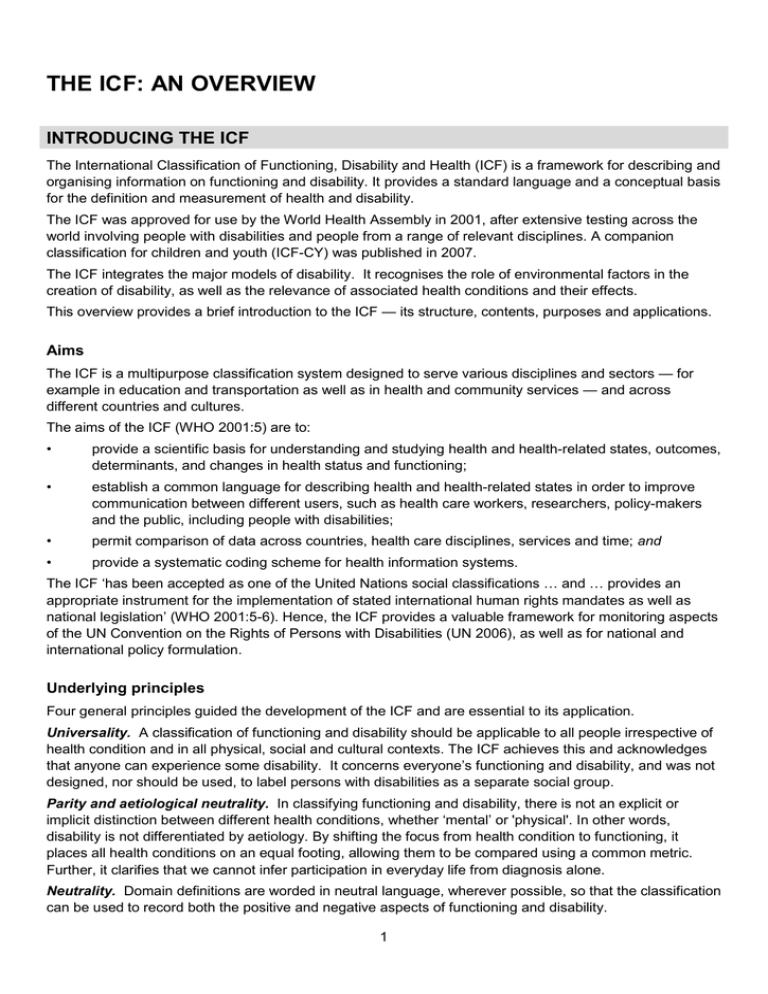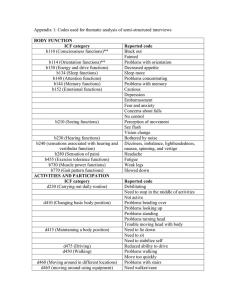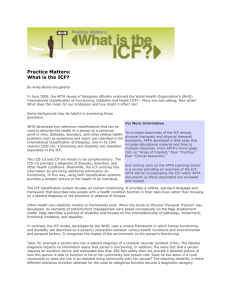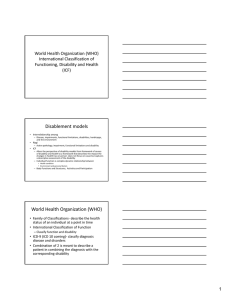THE ICF: AN OVERVIEW INTRODUCING THE ICF
advertisement

THE ICF: AN OVERVIEW INTRODUCING THE ICF The International Classification of Functioning, Disability and Health (ICF) is a framework for describing and organising information on functioning and disability. It provides a standard language and a conceptual basis for the definition and measurement of health and disability. The ICF was approved for use by the World Health Assembly in 2001, after extensive testing across the world involving people with disabilities and people from a range of relevant disciplines. A companion classification for children and youth (ICF-CY) was published in 2007. The ICF integrates the major models of disability. It recognises the role of environmental factors in the creation of disability, as well as the relevance of associated health conditions and their effects. This overview provides a brief introduction to the ICF — its structure, contents, purposes and applications. Aims The ICF is a multipurpose classification system designed to serve various disciplines and sectors — for example in education and transportation as well as in health and community services — and across different countries and cultures. The aims of the ICF (WHO 2001:5) are to: • provide a scientific basis for understanding and studying health and health-related states, outcomes, determinants, and changes in health status and functioning; • establish a common language for describing health and health-related states in order to improve communication between different users, such as health care workers, researchers, policy-makers and the public, including people with disabilities; • permit comparison of data across countries, health care disciplines, services and time; and • provide a systematic coding scheme for health information systems. The ICF ‘has been accepted as one of the United Nations social classifications … and … provides an appropriate instrument for the implementation of stated international human rights mandates as well as national legislation’ (WHO 2001:5-6). Hence, the ICF provides a valuable framework for monitoring aspects of the UN Convention on the Rights of Persons with Disabilities (UN 2006), as well as for national and international policy formulation. Underlying principles Four general principles guided the development of the ICF and are essential to its application. Universality. A classification of functioning and disability should be applicable to all people irrespective of health condition and in all physical, social and cultural contexts. The ICF achieves this and acknowledges that anyone can experience some disability. It concerns everyone’s functioning and disability, and was not designed, nor should be used, to label persons with disabilities as a separate social group. Parity and aetiological neutrality. In classifying functioning and disability, there is not an explicit or implicit distinction between different health conditions, whether ‘mental’ or 'physical'. In other words, disability is not differentiated by aetiology. By shifting the focus from health condition to functioning, it places all health conditions on an equal footing, allowing them to be compared using a common metric. Further, it clarifies that we cannot infer participation in everyday life from diagnosis alone. Neutrality. Domain definitions are worded in neutral language, wherever possible, so that the classification can be used to record both the positive and negative aspects of functioning and disability. 1 Environmental Influence. The ICF includes environmental factors in recognition of the important role of environment in people’s functioning. These factors range from physical factors (such as climate, terrain or building design) to social factors (such as attitudes, institutions, and laws). Interaction with environmental factors is an essential aspect of the scientific understanding of 'functioning and disability'. THE ICF MODEL In the ICF, functioning and disability are multi-dimensional concepts, relating to: the body functions and structures of people, and impairments thereof (functioning at the level of the body); the activities of people (functioning at the level of the individual) and the activity limitations they experience; the participation or involvement of people in all areas of life, and the participation restrictions they experience (functioning of a person as a member of society); and the environmental factors which affect these experiences (and whether these factors are facilitators or barriers). The ICF conceptualises a person's level of functioning as a dynamic interaction between her or his health conditions, environmental factors, and personal factors. It is a biopsychosocial model of disability, based on an integration of the social and medical models of disability. As illustrated in Figure 1, disability is multidimensional and interactive. All components of disability are important and any one may interact with another. Environmental factors must be taken into consideration as they affect everything and may need to be changed. ICF: Interaction of concepts Health condition (disorder or disease) Body Functions and Structures Activities Participation Personal Factors Environmental Factors 4 4 Figure 1: Interactions between the components of ICF (WHO 2001:18) Although personal factors are recognised in the interactive model shown in Figure 1, they are not classified in the ICF at this time. Such factors influence how disability is experienced by the individual and some, such as age and gender, are commonly included in data collections. The ICF can provide or underpin a descriptive profile of an individual's pattern of functioning, not a 'yes' or 'no' answer about whether he or she is disabled. A decision about where to draw a line between ‘no disability’ and ‘disability’ depends on the purposes for doing so. Individual measures, surveys and other applications must be based on this understanding as well as the knowledge that there are multiple dimensions of disability, and potentially multiple perspectives to consider. Different measurement or policy purposes may result in different decisions about which aspects of disability to focus on and which thresholds are relevant – and hence in different measures and estimates at individual or population level. 2 ICF components and their contents The major components of functioning and disability are set out and defined in Box 1; these are understood ‘in the context of health’ which clarifies that participation restrictions related to other factors, for example racial prejudice, are not within the scope of the ICF. Box 1: Definitions: Functioning, disability and the components of the ICF Body functions - The physiological functions of body systems (including psychological functions). Body structures - Anatomical parts of the body such as organs, limbs and their components. Impairments - Problems in body function and structure such as significant deviation or loss. Activity - The execution of a task or action by an individual. Participation - Involvement in a life situation. Activity limitations - Difficulties an individual may have in executing activities. Participation restrictions - Problems an individual may experience in involvement in life situations. Environmental factors - The physical, social and attitudinal environment in which people live and conduct their lives. These are either barriers to or facilitators of the person's functioning. Functioning is an umbrella term for body function, body structures, activities and participation. It denotes the positive or neutral aspects of the interaction between a person’s health condition(s) and that individual’s contextual factors (environmental and personal factors). Disability is an umbrella term for impairments, activity limitations and participation restrictions. It denotes the negative aspects of the interaction between a person’s health condition(s) and that individual’s contextual factors (environmental and personal factors). Source: WHO 2001:8,10 Each component contains hierarchically arranged domains. These are sets of related physiological functions, anatomical structures, actions, tasks, areas of life, and external influences. The ICF has a separate chapter for each of the domains as listed in Table 1. Table 1: ICF components and domains/chapters Body Function: Activities and Participation: Mental functions Learning and applying knowledge Sensory functions and pain General tasks and demands Voice and speech functions Communication Functions of the cardiovascular, haematological, immunological and respiratory systems Mobility Self care Functions of the digestive, metabolic, endocrine systems Genitourinary and reproductive functions Domestic life Interpersonal interactions and relationships Neuromusculoskeletal and movement-related functions Major life areas Functions of the skin and related structures Community, social and civic life Body Structure: Environmental Factors: Structure of the nervous system Products and technology The eye, ear and related structures Natural environment and human-made changes to environment Structures involved in voice and speech Support and relationships Structure of the cardiovascular, immunological and respiratory Systems Attitudes Structures related to the digestive, metabolic and endocrine systems Services, systems and policies Structure related to genitourinary and reproductive systems Structures related to movement Skin and related structures 3 Source: WHO 2001: 29-30 Measurement The ICF is a framework and classification system on which tools for measuring or ‘assessing’ individual functioning may be based, and to which they can be mapped. The broad framework puts assessment in context and provides the focus for selecting relevant aspects of functioning and disability for assessment. Qualifiers are codes used to record the extent of functioning or disability in a domain or category, or the extent to which an environmental factor is a facilitator or barrier. A uniform or 'generic' qualifier scale is provided to record the extent of the 'problem' in relation to impairment, activity limitation and participation restriction as shown in Box 2. The environmental factors qualifier uses both a positive and negative scale, to indicate the extent to which an environmental factor acts as either a facilitator or barrier to functioning. Measurement is an area for further development and it is recognised that the generic qualifier requires calibration to relate its scale to existing measurement tools. Box 2: ICF Qualifier scales Generic qualifier: 0 No problem 1 Mild problem 2 Moderate problem 3 Severe problem 4 Complete problem 8 Not specified 9 Not applicable Qualifier for Environmental factors: .0 No barrier +0 No facilitator .1 Mild barrier +1 Mild facilitator .2 Moderate barrier +2 Moderate facilitator .3 Severe barrier +3 Substantial facilitator .4 Complete barrier +4 Complete facilitator .8 Barrier, not specified +8 Facilitator, not specified .9 Not applicable +9 Not applicable Two constructs, 'performance' and 'capacity', can be used in operationalising the qualifier scale for the activities and participation domains. These constructs provide a way of indicating how the environment (in which measurement has taken place) impacts on a person’s activities and participation, and how environmental change may improve a person’s functioning. ‘Capacity’ relates to what an individual can do in a ‘standardised’ environment (this often involves some kind of clinical assessment). ‘Performance’ relates to what the person actually does in his or her ‘current’ (usual) environment. ‘The gap between capacity and performance reflects the difference between the impacts of current and uniform environments, and thus provides a useful guide as to what can be done to the environment of the individual to improve performance’ (WHO 2001:15) There are a variety of optional and additional qualifiers that can be useful, including qualifiers for performance without assistance and capacity with assistance, which are particularly useful in institutionalised settings. A ‘qualifier for involvement or subjective satisfaction’ for the activities and participation component is a future possibility (WHO 2001:230-231). 4 APPLYING THE ICF In statistics and information systems In developing collections of information on functioning and disability it is important to consider all components of the ICF. A common definition of disability is crucial to understanding and improving outcomes for people with disabilities as well as for increasing the power of information through the ability to relate data from different sources, such as in service settings and at the population level. When consistent language and concepts are used, they facilitate comparisons, complementary information and knowledge building. Synergy is enabled between different information systems such as surveys, research and health records. Classification systems have been described as the building blocks of statistical information. ‘The WHO family of international classifications provides a framework to code a wide range of information about health … so that people can communicate about health and health care in common terms, across various disciplines and between countries.’ (WHO 2001:3). The ICF is recognised as a reference member of the WHO family of international classifications (WHOFIC), and complementary to the International Statistical Classification of Diseases and Related Health Problems (ICD). Health conditions are classified using the ICD (most current version is ICD-10), which provides codes for diseases, disorders, injuries or other health problems. As functioning and disability associated with health conditions are classified using the ICF, the use of the ICD-10 and the ICF together provides a more meaningful and complete picture of the health needs of people and populations (WHO 2001:4). The examples in Figure 2 illustrate disabilities that may be associated with some health conditions and environmental factors. When population data use the same concepts and frameworks as administrative and service data, a strong, integrated national information array can be developed. For example, Australian national data standards (based on the ICF) are designed to promote some uniformity and standardisation of definition and data collection, without dictating the precise content of collections. The Washington Group on Disability Statistics has worked to create, test and adopt a short set of six questions for use in censuses and surveys, following the Fundamental Principles of Official Statistics and consistent with the ICF. 5 Figure 2: Examples of ICF use with individuals Spinal Cord Injury Problems of muscle power f unctions & structure of spinal cord Public transport, building design: barriers Dif f iculty moving & walking Spinal Cord Injury Restricted participation in employment & in using public transport Problems of muscle power f unctions & structure of spinal cord Male, 30 yrs Dif f iculty moving & walking Education system, products and technology, building design, immediate f amily: f acilitators Participation in employment, sport and leisure: no problems Male, 35 yrs, married with one child Notes: 1. The examples above are not intended to represent a complete picture of activity limitations, participation restrictions or impairments, but rather represent a few domains of each component which could be related to a particular health condition and some environmental factors. Each example is based on the assumption that Activities and Participation can be distinguished by domains (just one option for their use – see WHO 2001: 234-237). 2. For specific situations and/or individuals the direction or magnitude of the arrows may differ, however the two-directional arrows are retained in Figure 2 to illustrate the usual multi-directional influence. 6 The range of other applications The ICF provides a framework for the description of human functioning, on a continuum. It is important to remember that it classifies functioning, not people. Because the development and testing of the ICF involved people from a broad range of backgrounds and disciplines, including people with disability, the ICF has a wide range of potential applications. People use the ICF across broad sectors including health, disability, rehabilitation, community care, insurance, social security, employment, education, economics, social policy, legislation and environmental design and modification. The ICF offers an international, scientific tool to study disability, in all its dimensions. It may be used by persons with disabilities and professionals alike, across different sectors and care settings, (e.g., community services and support, primary care, hospitals, rehabilitation centres, nursing homes) and populations. Examples of application Some of the applications of the ICF that demonstrate its versatility and utility as a model of functioning and disability, and as a common language, are as follows: The ICF and its model have been introduced into legislation and social policy in some countries. For example it is used in social security and registration systems in Latin America. As more countries ratify the UN Convention on the Rights of Persons with Disabilities, it is hoped that the ICF will become the world standard for disability data and social policy modeling for all countries. It provides a valuable information framework for monitoring mechanisms in order for countries to report to the UN on progress against the Convention’s targets. In clinical settings the ICF can be used in its full range as a framework for rehabilitation programming (Martinuzzi et al 2010). For specific disease conditions, instead of using the entire ICF (with its approximately 1400 categories) it can be useful to have a short list of ICF categories that are essential to describe the disability experience of the person. To achieve this, ICF ‘core sets’ have been developed with practitioners and people who experience the disease, in a systematic consensus approach (see www.icf-research-branch.org/publications/publications ). The ICF can be used to underpin reforms in education, employment or social welfare and ensure coherent implementation across different levels and sectors. For example in Switzerland, the ICF is used in education as a model and classification to establish eligibility (see www.sav-pes.ch) and to organise school-based support (Hollenweger, Lienhard 2007). In Italy a nationwide experience in the employment sector and local experiences in education have shown great potential (see www.reteclassificazioni.it/). NGOs delivering disability services see the value in using the ICF (see example of a children’s services organisation at www.novita.org.au/Content.aspx?p=573). The definition of disability can influence advocacy cases and the ICF can be used to support the rights based approach to disability. This broader potential value of the ICF was recognised by advocates involved in its development (Hurst 2003). The ICF is suitable for use in community based life and care, and across multi-disciplinary care. The model can be used to underpin case planning, monitoring of progress, and outcomes evaluation. It is consistent with an approach to care and treatment that is person-centred, a partnership, and holistic. Accordingly, its use in primary care has been advocated (e.g. Veitch et al 2009). The ICF is valuable as a unifying model in rehabilitation medicine practice, research and education (Stucki et al 2007). It assists professionals to look beyond their own areas of practice, communicate across disciplines, and think from a functioning perspective rather than the perspective of a health condition. 7 There is a growing body of research focused on the use of the ICF, not only for identifying people’s health care, rehabilitative and support needs, but also for identifying and measuring the effect of the physical, social and policy environments in their lives. Ethical use Every scientific tool can be misused, and the ICF is no exception. For all uses of ICF—clinical, research, epidemiological, health and social policy—it is essential that information gathered and analysed must respect the inherent value and autonomy of the individuals from whom the information is gathered. Standard rules about informed consent apply, but more importantly people with disabilities must participate in all aspects of the use of ICF and the application of the data produced. Full participation and transparency of use are most important in the social applications of ICF and, in particular, with the anticipated use of ICF for the development of indicators for monitoring the implementation of the UN Convention on the Rights of Persons with Disabilities. This important human rights document—which embodies precisely the same conceptual refinement of functioning and disability as the ICF—is our moral compass towards the development of social policy and political change needed to achieve the full participation of persons with disabilities. The ethical application of ICF seeks to support and further this mandate for the future. 8 REFERENCES AND LINKS American Psychological Association Procedural Manual and Guide for the Standardized Application of the ICF: http://www.apa.org/monitor/jan06/changing.aspx Australian ICF-related data standards: http://meteor.aihw.gov.au/content/index.phtml/itemId/320319 Hollenweger, J., Lienhard, P. (2007). Schulische Standortgespräche. EinVerfahren zur Förderplanung und Zuweisung von sonderpädagogischen Massnahmen. Bildungsdirektion des Kantons Zürich. Zürich: Lehrmittelverlag des Kantons Zürich. Hurst R 2003. The international disability rights movement and the ICF. Disability and Rehabilitation Vol 25, No, 1112, 572-576 ICF checklist: http://www.who.int/classifications/icf/training/icfchecklist.pdf Martinuzzi, A, Salghetti, A, Betto, S, et al. (2010). The international classification of functioning disability and health, version for children and youth as a road-map for projecting and programming rehabilitation in a neuropaediatric hospital unit. J Rehabil Med 42: 49-55 Stucki G, Reinhardt JD, Grimby G, Melvin J 2007. Developing ‘human functioning and rehabilitation research’ from the comprehensive perspective. J Rehabil Med 2007; 39: 665-671 United Nations 2006. Convention on the Rights of Persons with Disabilities. http://www.un.org/disabilities/default.asp?navid=12&pid=150 Veitch C, Madden R, Britt H, Kuipers P, Brentnall J, Madden R, Georgiou A, Llewellyn G 2009. Using ICF and ICPC in primary health care provision and evaluation: http://www.who.int/classifications/network/WHOFIC2009_D009p_Veitch.pdf Washington Group on Disability Statistics http://unstats.un.org/unsd/methods/citygroup/washington.htm WHODAS2 http://www.who.int/classifications/icf/whodasii/en/index.html WHO Family of International Classifications http://www.who.int/classifications/en/ WHO Family of International Classifications Network (including a list of Collaborating Centres): http://www.who.int/classifications/network/en/ World Health Organization 2001. ICF browser: http://apps.who.int/classifications/icfbrowser/ World Health Organization 2001. The International Classification of Functioning, Disability and Health (ICF). Geneva: WHO. http://www.who.int/classifications/icf/en/ World Health Organization (2007) The International Classification of Functioning, Disability and Health, Children and Youth version Geneva: WHO. http://www.who.int/classifications/icf/en/ FURTHER INFORMATION AND RESOURCES For further information contact: Dr. T.B. Üstün World Health Organization Coordinator, Classification, Terminology and Standards 20 Avenue Appia CH-1211 Geneva 27 Switzerland Tel: 41 22 791.36.09 Fax: 41 22 791.48.85 E-mail: ustunb@who.int 9 The Functioning and Disability Reference Group In 2006 the WHO Family of International Classifications (WHO-FIC) Network established the Functioning and Disability Reference Group (FDRG) to advise on functioning, disability and health classification and coding issues. The FDRG has developed a work program to enable it to provide well researched advice. Topics include coding guidelines, ICF updates, ICF-ICD joint use, education, ethical use of ICF, measurement and environmental factors. The FDRG works collaboratively with other committees and reference groups in the WHO-FIC Network to address these issues. The FDRG now has over 30 members worldwide, including people from various disciplines and organisations. Disabled people’s organisations (DPO) and an even broader collaborative network are involved in its work. The motivations for this work program include: The need to educate people and potential users about the ICF The need to reflect on ICF implementation – useful applications, new ideas and commentary, challenges, gathering new knowledge gained from experience with its use The need to develop useful tools to make ICF use easy and relevant The need to update the ICF in the light of experience This Overview was produced by members of the FDRG, in collaboration with the Education Committee of the WHO-FIC Network, for use by the Network and WHO. 10






